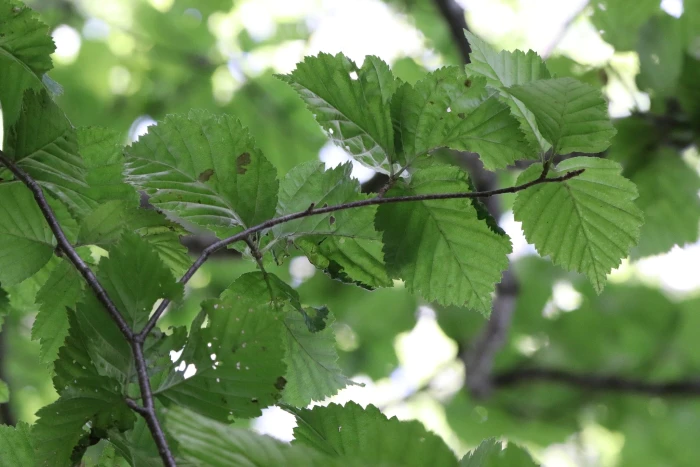Alder-Leafed Whitebeam
(Alniaria alnifolia)
Alder-Leafed Whitebeam (Alniaria alnifolia)
/
/

Nina Filippova
CC BY 4.0
Image By:
Nina Filippova
Recorded By:
Copyright:
CC BY 4.0
Copyright Notice:
Photo by: Nina Filippova | License Type: CC BY 4.0 | License URL: http://creativecommons.org/licenses/by/4.0/ | Rights Holder: Nina Filippova | Publisher: iNaturalist | Date Created: 2021-09-04T12:57:25-07:00 |



















Estimated Native Range
Climate Requirements for Turin, Italy
| This Plant | Your Site | Plant Suitability for Your Location | ||
|---|---|---|---|---|
| • Precipitation | 14" - 127" | 34" | Your precipitation may be insufficient for this plant. Irrigate N" / year. | Irrigate N" / year |
| • High Temp. | 57°F - 93°F | 84°F | Your summer temperatures are normal for this plant. | Excellent |
| • Low Temp. | -15°F - 52°F | 31°F | Your winter temperatures are normal for this plant | Excellent |
This plant should grow well at your location with about N inches per year (Y minutes per month) of irrigation.
Summary
Alniaria alnifolia, commonly known as the alder-leafed whitebeam, Korean whitebeam, or Korean mountain ash, is a medium-sized deciduous tree. It is native to the cool temperate regions of East Asia, including Korea, Japan, and parts of China, where it is found in mixed forests and mountainous areas. This species typically grows to a height of 10–20 meters with a trunk up to 30 cm in diameter. The grey bark is smooth, and the crown takes on a columnar or conic shape in young trees, becoming more rounded with age. Branches are angled upwards with slender shoots. The leaves resemble those of an alder, contributing to its common name. The autumn color of the foliage is a striking orange-pink to red. Flowers are showy, 10–18 mm in diameter, with five white petals and 20 yellowish-white stamens, blooming in corymbs 4–8 cm in diameter in late spring. The bright red fruit is a globose pome, 8–15 mm in diameter, maturing in mid-autumn.
The alder-leafed whitebeam is valued for its ornamental features, particularly its vibrant autumn foliage and attractive flowers. It is occasionally planted in northern Europe as an ornamental tree in urban settings, botanical gardens, and parks. This tree is relatively low-maintenance, but it does best in full sun and requires medium amounts of water. It is adaptable to a range of soil types, provided they have slow to fast drainage. While it is not commonly known for significant disease issues, it can be susceptible to fireblight and canker diseases. Gardeners should be aware of these potential problems and monitor for signs of infection.CC BY-SA 4.0
The alder-leafed whitebeam is valued for its ornamental features, particularly its vibrant autumn foliage and attractive flowers. It is occasionally planted in northern Europe as an ornamental tree in urban settings, botanical gardens, and parks. This tree is relatively low-maintenance, but it does best in full sun and requires medium amounts of water. It is adaptable to a range of soil types, provided they have slow to fast drainage. While it is not commonly known for significant disease issues, it can be susceptible to fireblight and canker diseases. Gardeners should be aware of these potential problems and monitor for signs of infection.CC BY-SA 4.0
Plant Description
- Plant Type: Tree
- Height: 40-50 feet
- Width: 20-25 feet
- Growth Rate: Rapid
- Flower Color: White
- Flowering Season: Spring
- Leaf Retention: Deciduous
Growth Requirements
- Sun: Full Sun
- Water: Medium
- Drainage: Slow, Medium, Fast
Common Uses
Bird Garden, Low Maintenance, Showy Flowers, Street Planting
Natural Habitat
Native to the cool temperate regions of East Asia, including Korea, Japan, and parts of China, found in mixed forests and mountainous areas
Other Names
Common Names: Mountain Ash, Alder-Leafed Whitebeam, Korean Whitebeam
Scientific Names: Sorbus alnifolia, Alniaria alnifolia, Aria alnifolia, Sorbus alnifolia var. lobulata, Sorbus alnifolia var. alnifolia, Sorbus alnifolia f. hirtella, Micromeles alnifolia, Sorbus alnifolia f. oblongifolia, Sorbus alnifolia var. submollis
GBIF Accepted Name: Alniaria alnifolia (Sieb. & Zucc.) Rushforth